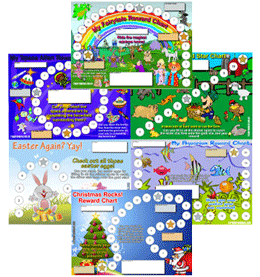There are many rules that may be followed in order to allow for the best opportunity of success, but there are three very important principles that underlie the successful use of reward charts.
- Be Positive: Studies have consistently shown that positive incentives and positive reinforcement are very effective in developing change in behavior. These have also demonstrated how a consistent flow of negative comments, criticizing and punishing your child can adversely effect the self-esteem of your child, and damages the chance for children to respond to the opportunities of positive learning that parents are trying to create. The effective use of our reward charts allow for the parents to emphasize the positives in their child’s behavior.
- Be Consistent: Critical to the success of our reward charts is in being consistent in the reinforcing of good behavior. Without being overbearing, find opportunities to consistently remind your child about the chart and what it is all about (remember the chart is meant to be fun, keep this in mind when reminding your child), and keep the chart in a central and visible location to help with your child’s and your awareness of the chart and the related outcomes. Be consistent with the allocation of stickers and keep up your side of the bargain when handing out the rewards. This will demonstrate to your child that you are serious about using the reward charts and will help develop and maintain your child’s trust in using the reward chart system, and in turn develop and maintain your child’s motivation and focus.
- Be Realistic: It is vital when setting goals that they are realistic and attainable. A child will quickly become overwhelmed if you expect too big a change too quickly. Be sure to set goals for good behavior that are comfortably demanding and allow for success if your child puts in a reasonable amount of effort. Always consider the age of your child as well as their emotional and psychical developmental stage.
Almost all of the following rules are underpinned by these three critical principles. Some are self-explanatory and some may require further thought. Some may not completely apply to your child (for example, if your child is older, he may not respond positively to constant reminders or to constant overt praise). Some are repeated in various forms but all in their way are important to varying degrees (according to your child’s personality and their personal level of development).
The Reward Chart Rules (in no particular order)
- Keeping it simple is best. No more than one to three charts at a time.
- Explain ahead of time, how the reward chart will be used.
- Involve your child in choosing the rewards ahead of using the chart. This will give your child a sense of involvement and ownership over the process of using the reward chart.
- Never take away stickers for misbehavior. Reward charts are a positive behavior strategy. Once they’ve earned the sticker it’s theirs to keep. If they don’t earn a sticker and become argumentative, or become upset, express sadness that they didn’t get it, emphasize that another chance will come along soon, and then move on.
- Never renege on an agreed to reward. If a child has earned it, then they deserve it. Not following through on the reward will cause mistrust.
- Keep the charts in a highly visible place so they can be seen as a constant positive reminder.
- Be realistic. The charts need to be achievable in relation to the child’s age and development. Children will become disheartened quickly if the expectations placed on them are too high too soon.
- Strive to be positive, and praise their successes.
- Encourage your child’s involvement before starting a reward chart. It’s important that they are willing to tackle the reward chart, and know how it is going to work.
- When creating tasks for your child, it helps if you make them small and visually observable. This way it is clear to both you and your child that the expectation has been met. The tasks are either done … or they aren’t. For example water the plants, feed the dog, pick up clothes off the floor, wake up with a dry bed etc.
- When establishing the chart and setting the tasks, it’s important to be specific. Avoid generalized descriptions such as “be good”, “be nice to your brother”, “help parents” – tasks like these dis-empower your child because the parent is made the judge of whether the task has been done or not. Stick to things your child can feel a sense of accomplishment for.
- Show consistency. If you show a loss of interest in the reward chart then your child is more likely to lose motivation.
- Be sure that all carers such as parents, grand-parents, child-miners etc, are being consistent when rewarding your child.
- Use lots of verbal praise and stay positive.
- If you ever become seriously concerned about the behavior of your child, always seek consultation from a professional such as a G.P., mental health practitioner, teacher or health visitor etc.

